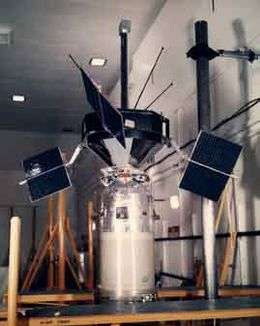Explorer 14
 | |
| Mission type | Earth science |
|---|---|
| Operator | NASA |
| Harvard designation | 1962 Beta Gamma 1 |
| COSPAR ID | 1962-051A |
| SATCAT no. | 432 |
| Mission duration | 10 months |
| Spacecraft properties | |
| Manufacturer | Goddard Space Flight Center |
| Launch mass | 40 kilograms (88 lb) |
| Start of mission | |
| Launch date | October 2, 1962, 22:11:30 UTC |
| Rocket | Delta A |
| Launch site | Cape Canaveral LC-17B |
| End of mission | |
| Last contact | August 11, 1963 |
| Decay date | May 25, 1988 |
| Orbital parameters | |
| Reference system | Geocentric |
| Regime | Highly elliptical |
| Semi-major axis | 78,707 kilometres (48,906 mi) |
| Eccentricity | 0.8389330 |
| Perigee | 2,601.0 kilometers (1,616.2 mi) |
| Apogee | 96,189.0 kilometers (59,769.1 mi) |
| Inclination | 42.80 degrees |
| Period | 2184.60 minutes |
| RAAN | 212.21 degrees |
| Mean anomaly | 333.98 degrees |
| Mean motion | 0.6673 |
| Epoch | 16 April 1965, 20:39:58 UTC |
| Revolution no. | 122 |
Explorer 14 was a spin-stabilized, solar-cell-powered spacecraft instrumented to measure cosmic-ray particles, trapped particles, solar wind protons, and magnetospheric and interplanetary magnetic fields. A 16-channel PFM/PM time-division multiplexed telemeter was used. The time required to sample the 16 channels (one frame period) was 0.323 s. Half of the channels were used to convey eight-level digital information, and the others were used for analog information. During ground processing of the telemetered data, the analog information was digitized with an accuracy of 1/100 of full scale. One analog channel was subcommutated in a 16-frame-long pattern and was used to telemeter spacecraft temperatures, power system voltages, currents, etc. A digital solar aspect sensor measured the spin period and phase, digitized to 0.041 s, and the angle between the spin axis and sun direction to about 3-degree intervals.[1][2]
Experiments
There were eight experiments done on the Explorer 14 during its mission.[3]
- Proton Analyzer
- Fluxgate Magnetometers
- Trapped Particle Radiation
- Cosmic Rays
- Proton-Electron Scintillation Detector
- Solar Aspect Sensor
- Electrolytic Timer Experiment
- Solar Cell Damage Experiment
References
![]()
External links
.png)